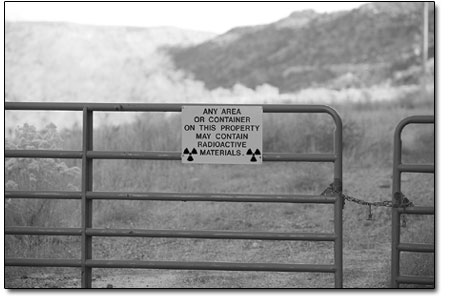| ||
| A uranium paradox Proposed uranium mill nears end of the permitting process SideStory: The price of permitting – Energy Fuels runs short on cash
by Will Sands The fight for Paradox Valley is heading into the final rounds. The nation’s first uranium mill in 25 years is nearing the end of the permitting process and hopes to break ground not far from Durango early in 2011. However, opponents of the Piñon Ridge Mill are vowing to keep the facility in the hot seat and out of the Western Slope. Energy Fuels Inc., a Toronto-based uranium and vanadium mining company, has high expectations for the Piñon Ridge Mill. The mill would be sited in the middle of Western Colorado’s uranium belt on 1,000 acres of privately owned land in Paradox Valley, not far from the Dolores River. The facility would be the nation’s first in a quarter century and located not far from the only other operating uranium mill in the country, the White Mesa Mill near Blanding. Since it was first announced, the mill has effectively split the Western Slope. Hundreds of residents of Naturita and Nucla have come out in support of the new mill and the economic stimulus it could offer the impoverished “West End” of Montrose County. However, hundreds of other area residents have voiced their opposition to a plan they consider hazardous and objected to Energy Fuels’ plan to process 500 tons of uranium a day, 350 days a year. “The site itself is a problem,” explained Hilary White, executive director of the Telluride-based Sheep Mountain Alliance. “The fact that it is hydrologically connected to the Dolores River is a major issue. Energy Fuels is talking about putting a 40-acre tailings pond on the site, and that will inevitably leak into the aquifer. All tailings ponds eventually leak.” White added that the mill will require an estimated 40 gallons per minute of water to process the ore. However, Energy Fuels currently has no water rights in a region where the wet stuff is a hot and valuable commodity. “They really don’t have any water at the moment and say they’re just going to borrow the water from the Town of Naturita when the time comes,” White said. “That really doesn’t cut it for us. We do not see any reasonable alternative to the denial of this proposal.” However, Energy Fuels disputes these and other criticisms of its Piñon Ridge plans. The company is nearing the end of a long permitting process with the Colorado Department of Public Health and Environment and maintains that the facility will be the “the most environmentally friendly mill in the world.” The CDPHE is scheduled to issue its decision sometime prior to Jan. 17, and Energy Fuels is confident that it will be an approval. “Our original application to the state included 15 volumes of several hundred pages each that formed a stack more than 5 feet thick,” said Frank Filas, environmental manager for Energy Fuels. “In addition, we’ve honored four separated requests from the agency for more information, one of which contained over 300 technical questions. Let me just say that we’re very pleased with the jobs our staff and consultants have done on this application. We’re confident that the state will see our application in a positive light.”Filas added that he believes concerns about radioactive contamination from the mill are unfounded. He noted that Energy Fuels and the State of Colorado are taking great pains to avoid a repeat of the last uranium boom, which left a rash of illness and abandoned mine and mill sites in its wake. “The State of Colorado’s regulations for the uranium industry, and milling in particular, are stronger than the Nuclear Regulatory Commission’s,” he said. “We will have controls on all of our emission points, and the levels will be substantially lower than they were in the ’50s and ’60s. Plus, the ore we’ll be processing will be mined in Utah and Western Colorado and transported short distances.” Energy Fuels currently owns the Whirlwind Mine in Mesa County and the Energy Queen Mine near La Sal, Utah. Early in October, the company was awarded an additional 641-acre lease tract from the Department of Energy. Located not far from the mill in San Miguel County, the tract is believed to contain 156,000 pounds of uranium. With these three sources, Filas expects Energy Fuels to provide two-thirds of the feed for the mill with the remainder coming from mines in the Four Corners region. Supply aside, Piñon Ridge’s opponents maintain that radioactivity is no longer welcome in the Paradox Valley. White noted that the regulations may be on the books in Colorado, but that enforcement is lacking. “We’re not just talking about the Piñon Ridge Mill. We’re talking about the redevelopment of mines and the industry throughout the region along with the resulting contamination,” she said. “The laws may be on the books, but they are not being enforced, and this area will be devastated by an under-regulated industry.” When the State of Colorado finishes wading through Energy Fuels’ 5-foot stack, it will either approve the mill, deny it or approve it with conditions. Though Energy Fuels is confident that Piñon Ridge will gain the CDPHE’s stamp of approval, the company realizes that the fight is far from over. “We’d love to break ground Jan. 18,” Filas said. “But there is an administrative appeals process, and we anticipate that one or more groups will file an appeal and that will certainly set the construction date back.” White confirmed Filas’ suspicions, noting that Sheep Mountain Alliance recently hired an environmental consultant and economics professor to look into hydrologic concerns and a socioeconomic analysis of the mill. She added that the conservation group is far from letting go of Paradox Valley. “Ultimately, we can hope for a denial,” White concluded. “But the truth is we are preparing for an approval and all of the action that will follow it.”
|


